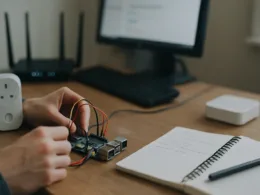Streamlining Developer Productivity with AI: Best Practices for Integration
AI is changing how code gets written and shipped. I look at the practical side. No hype. I focus on signals you can measure and actions you can take. The goal is clearer: improve developer productivity with tools that help, not distract.
Measuring developer performance through AI insights
Start with what you can measure. Raw commit counts mean little. Cycle time, mean time to recovery and pull request age tell a lot more. Keep metrics tied to work that matters. I favour measures that show flow and friction. For example, repeated build failures or long review queues are hard signals. They point to pain you can fix.
AI Integration in development processes is already more than autocomplete. Modern tools can suggest fixes, flag flaky tests, and group related incidents. That shifts some discovery work from humans to machines. That saves time when the suggestions are precise. It wastes time when they are noisy. So the trick is tuning. Turn on suggestions for a small set of repositories first. Measure false positive rates. Adjust thresholds before widening the rollout.
Analytics change how I inspect performance. Instrument the pipeline. Capture timestamps for key events: ticket moved to in-progress, branch created, first review request, merge. Correlate those with deployment and incident data. Use analytics to find the places where automation will give the biggest return. For instance, if most delays occur between review request and first review, invest in codeowner rules, triage rotas or review bots.
Atlassian’s recent move to buy DX shows where the market is headed. Atlassian and DX aim to connect engineering data to measurable AI returns. The Computerworld piece on the deal lays out the ambition and the practical tilt of the acquisition. Computerworld article The Reuters report on the transaction gives the main terms and the framing that this is about engineering intelligence, not just another dashboard. Reuters report
Don’t read analytics as gospel. Data collection choices bias the view. I always ask three questions when a dashboard surprises me. What events feed this metric? Which repos are included? What human context is missing? If the answers are fuzzy, treat the insight as a lead, not a verdict.
Strategies for Optimising Developer Performance
Fixing problems starts with narrow experiments. Pick one bottleneck. Define a hypothesis. Run a short trial. Measure impact. Repeat. Keep the scope small. That keeps risk and cost low.
Identifying bottlenecks in software development needs concrete checks. I use simple scripts to pull timings from CI, PRs and issue trackers. A spreadsheet or a small dashboard that shows median and 90th percentile times is enough to start. Common bottlenecks I see are: slow CI, unclear acceptance criteria, and overloaded reviewers. Each has a different fix.
For slow CI, prune the test surface. Run unit tests in parallel and run heavyweight integration tests less often. Add flaky-test detection and quarantine flappers. For unclear acceptance criteria, add a lightweight checklist to PR templates. Make the checklist pass/failable by an automated check. For overloaded reviewers, rotate reviewers, add small review windows and set a maximum number of unreviewed PRs per reviewer.
Effective use of AI tools is not about flipping a switch. It is about instrumented rollouts and feedback loops. I follow three practical rules:
- Run a pilot on low-risk repos. Collect precision and recall for suggestions.
- Use human-in-the-loop for changes that touch shared libraries or infra.
- Automate acceptance for low-risk refactors only after a clear test signal.
In practice that looks like this. Enable AI suggestions on a documentation repo first. Measure acceptance rate of suggestions. If acceptance exceeds a threshold, try the same model on a utilities repo. Only then test it on core services.
Measuring and tracking developer productivity must focus on leading indicators. Look for shorter review cycles, fewer reverts, and faster time from ticket to production. Use one metric to guide and another to verify. For example, reduce PR age (guide) and monitor post-deploy incidents (verify). If PR age falls but incidents rise, stop and investigate.
Concrete verification steps matter. After a change, run a 30-day window of before/after comparison. Use the same sample of repos and similar workload. Document the result and keep the raw data. That avoids chasing vanity wins.
Final takeaways: pick specific bottlenecks, pilot AI where the risk is low, measure with event-based metrics and verify changes with test windows. Keep instrumentation honest. Small, measurable wins stack into real developer productivity improvements.








